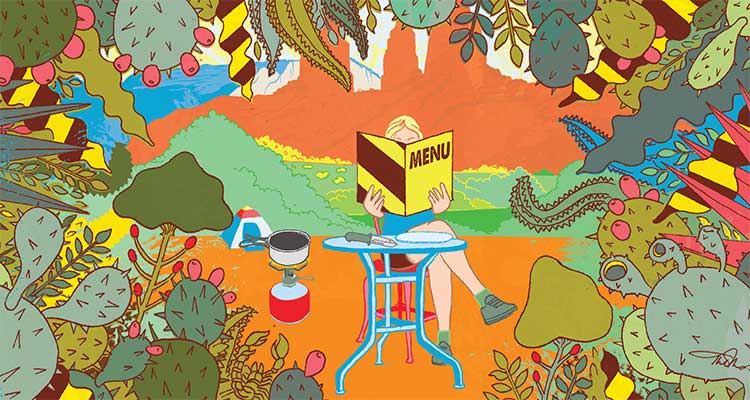Forage Your Dinner

'Image by Jacob Thomas'

Like many of us, I’ve watched episodes of Survivor and Naked and Afraid and wondered how I’d fare with only my wits and whatever I could scavenge from nature.
I grew up in the forested Southeast, where gathering food is as simple as plucking a few ripe blackberries, wild grapes, or any number of edible herbs. But for the past few years, I’ve lived in the Arizona desert. Would I be able to find a meal here without skinning a rattlesnake?
First, some research. I bought a local edible plants book and scoured desert survivalist websites. I was surprised to read that many cacti are edible, if you can get past the razor-sharp spines and tough skin. Other plants, like yucca and agave, have edible parts, but can make you nauseous if you don’t boil them first. Above all, the experts warned, you should be absolutely sure a plant is safe before taking a single bite.
To improve my chances, I drove a couple hours north one May weekend to the Mogollon Rim, where the Colorado Plateau rises a couple thousand feet above the Sonoran Desert. Its cooler temps and greater moisture translate to a wider menu of plants and wildlife. My plan: Hike in a couple miles and make a base camp from which I’d dayhike and forage.
At noon, I set out on a trail near my campsite, overturning rocks to look for grubs and crickets. But when I finally found some chubby white worms clinging to the underside of a stone, I shuddered. No doubt I could eat insects in a real survival situation (sautéed with garlic, maybe?), but I still had breakfast in the tank. I decided to hold out for something more appetizing. I eyed a stand of ponderosa pine, recalling I could make a fragrant tea from its needles. But tea is hardly a meal.
Two hours in and a couple miles down the trail with nothing to show for it, I reminded myself that edible and tasty don’t necessarily go hand in hand. I’d have to adjust my expectations if I wanted to eat. I eventually stumbled on a shallow, murky stream, most likely runoff from the rim above. Mosquitoes danced across the surface, and below I noticed something bigger moving along the bottom. Peering closer, I recognized it as a crayfish, something I’d seen hundreds of times growing up in Georgia. I grabbed the palm-size crustacean by its tail, careful to avoid its pinchers, and stashed it in my pack. I wanted to harvest more, but after searching another hour, I was growing impatient (and ravenous).
Back at camp, I dropped the lonely crayfish into a pot and tried to brainstorm an appropriate side dish. Looking around, there wasn’t much to choose from except pine needles and a few prickly pear cacti.
Prickly pear pads are about the size of a salad plate, with long spines and tiny, splinter-like barbs guarding the edible flesh. I jabbed a plump-looking specimen with my metal spork and cut it off at the base, then sliced off its barbed edges and stood the pad on end to filet it. I managed to prick my fingers a few times, but after 30 minutes I had a handful of gooey green insides. Though you can eat this raw, boiling yields a more pleasant flavor and reduces the slime factor, so I diced the cactus and tossed it into a pot of boiling water. After about 10 minutes, I tasted it and was pleasantly surprised: It was like a tangy green bean, with the texture of a cucumber.
Next, the crayfish, still writhing, went into the boiling water. It immediately turned pink, like a miniature lobster. I let it boil for a good five minutes, then pulled apart its shell to reveal about an ounce of meat in its tail and tiny claws. The flavor wasn’t bad, if bland: I found myself longing for a little butter and some Old Bay, and went to bed dreaming about the leftover meatloaf in my fridge back home.
The Verdict: Fail
The meal provided fewer than 500 calories—I probably burned more than that just collecting it. In a survival situation, I would have been better off staying put and eating cactus (and grubs). But if I can find food in the desert, I can find it anywhere—and with practice, I’m pretty sure I could forage more calories than I burn.
Key Skills
Warning Signs While it’s always best to only eat plants you can identify, certain characteristics indicate that a plant may be toxic, including thorns, shiny leaves, umbrella-shaped flowers, white or yellow berries, seed pods, milky sap, an almond scent, and leaves in groups of three. To determine if an unknown plant is safe to eat, use the universal edibility test.